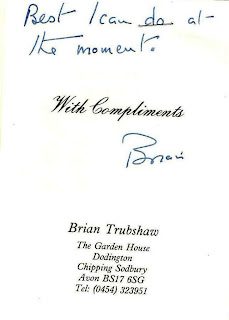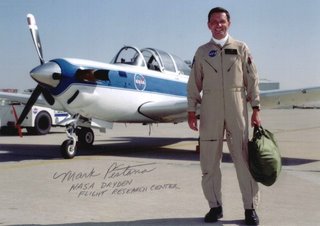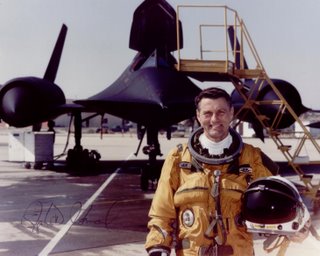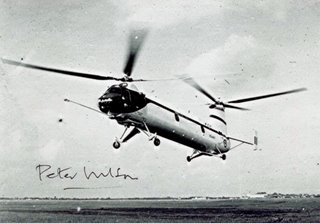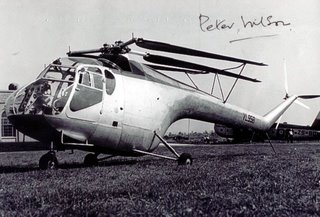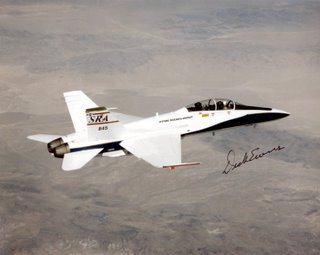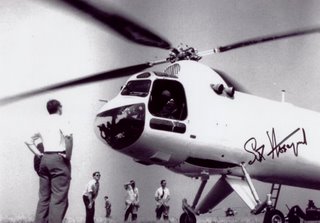Richard Frewen (Dicky) Martin OBE DFC* AFC 1918-2006


Wing Commander Dickie Martin fought with distinction as a fighter pilot over France and Tobruk; later he became one of Britain's foremost test pilots while also devoting much time to flying vintage aircraft with the Shuttleworth Trust.
Within weeks of completing his training in August 1939, Martin was flying Hurricanes with No 73, one of two RAF fighter squadrons rushed to France a few days after war was declared. In what became known as the "phoney war", he flew patrols to intercept lone bombers and reconnaissance aircraft.
On November 8 he was scrambled to intercept a high-flying bomber, but his oxygen system failed and he fainted at 21,000 ft. He recovered just in time to make a forced landing at an airfield in neutral Luxembourg, where he was interned. He was allowed out every day for exercise, and one foggy morning gradually widened his normal circuit before disappearing into the mist. When he returned on Boxing Day to his squadron, he was called the "Prisoner of Luxembourg".
As activity increased over northern France, Martin gained his first success on April 21 1940, when he probably destroyed a Messerschmitt Bf 110 fighter. Following the German Blitzkrieg on May 10, No 73 was in constant action. Martin shared in the destruction of a Dornier bomber, and four days later attacked a formation of Stuka dive-bombers, shooting down two and probably a third.
Although still only a junior pilot officer, he returned to England as an instructor, and was awarded the DFC.
In early April 1941 Martin rejoined No 73 at Tobruk just as Rommel launched his attack, and was immediately in action. He shared in the destruction of a reconnaissance aircraft, and shot down a Bf 109 on May 29. The following day he and six other pilots took off to intercept a raid by 60 aircraft. He was shot down during the fierce fight but, despite being wounded, was able to bale out.
After his recovery Martin was sent as a flight commander to No 250 Squadron, flying the Tomahawk. On the aircraft's operational debut he damaged a Bf 109, and two weeks later destroyed two Italian fighters. He was awarded a Bar to his DFC in August, and was also mentioned in dispatches.
Richard Frewen Martin was born on July 26 1918 at Bournemouth. He was educated at Cheltenham College and the RAF College at Cranwell, where he was awarded the prize for the best pilot in his entry.
After his time on No 250 in the desert, Martin instructed fighter pilots at RAF training schools at Khartoum and Aden before returning to England in 1943. A year later he converted to flying Dakota transport aircraft and left for India, where he joined No 52 Squadron. He was soon flying mail and supplies into Kunming, China, and, once the longer range Liberators had arrived on the squadron, he flew evacuation flights to Chungking. When the southerly advance into Burma began, resupply sorties to support the Fourteenth Army took on increasing importance.
At the end of the war Martin attended the Empire Test Pilots' School (ETPS) before becoming a flight commander with the Aerodynamic Research Flight at the Royal Aircraft Establishment, Farnborough. He tested the early experimental jets that led to the development of the Hunter, Swift and Sea Vixen fighter aircraft, for which he was awarded the AFC.
In 1949 Martin returned to the ETPS as an instructor for two years. After a staff appointment at the Air Ministry, he left the RAF in 1953 to become a test pilot at Gloster Aircraft Company, where he was appointed chief test pilot the following year. He joined the early testing programme of the delta-wing Javelin fighter, which had experienced control difficulties. In nearly 200 spins, Martin developed a technique for recovery.
Later a report appeared, strongly denied by the company, that the aircraft had serious defects at high speed. The following night Martin dived one over London, causing a sonic boom, which "just happened to be aimed at the Houses of Parliament". Thousands rushed into the streets where they claimed to have seen "blue flashes" and "meteorites". Martin suggested with a straight face that the noise was accidental – the result of his oxygen tube fouling the controls.
For almost seven years he tested every version of the Javelin and, by his perseverance, flying skill and management of the test programme, turned it into a successful aircraft which served on many night fighter squadrons. For his work at Glosters, Martin was appointed OBE.
In 1960 he joined AV Roe and tested Vulcan bombers, the Shackleton and the successful HS 748 airliner for a further seven years, being awarded a Queen's Commendation for Valuable Services in the Air. He then flew for various airlines before retiring from Monarch Airlines in 1984.
During his time at Glosters, Martin masterminded a project by the apprentices to restore to flying condition one of the company's pre-war Gladiator bi-planes. This was presented to the Shuttleworth Trust, which Martin had joined in 1948, and for many years he flew the aircraft at air shows. He was a member of the executive committee, and gave 42 years service to the trust, displaying many of the vintage aircraft in the collection.















